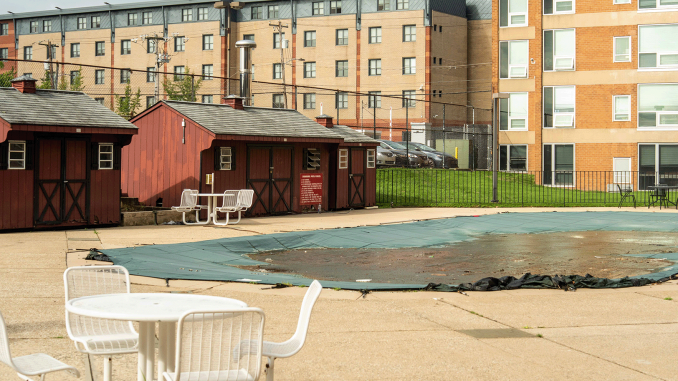
Philadelphia County is experiencing abnormally dry conditions and last month was the 21st driest August on record in 128 years.
Abnormally dry conditions, which have been recorded in Philadelphia as of Sept. 6, can stunt crop growth, increase fire risk and brown and wilt lawns, according to weekly updates from the National Integrated Drought Information System.
To combat these conditions and conserve water now and all-year-round, Temple University relies on its own sustainability practices, while educating students on what they can do to save water.
Temple’s main three sources of water conservation come from low-flow water fixtures, drought tolerant plants and gray water usage in buildings like Morgan Hall, said Caroline Burkholder, the sustainability manager in Temple’s Office of Sustainability.
The university’s conservation efforts reduce the university’s water usage by about 5 percent, said Joe Monahan, associate vice president of facilities and operations. Temple used slightly more than 432,500 kilogallons of water combined in its Main, Ambler, Health Sciences and Temple University Hospital campuses, during the 2021-22 academic year, according to facilities management data. In July, Temple used slightly more than 16,200 kilogallons of water between the four campuses.
The fixtures have been mostly on Main Campus for 20 years and are found in some of the newer buildings on campus like Charles Library, 1810 Liacouras Walk and the Aramark STAR Complex, Monahan said. During the COVID-19 pandemic, the university installed 400 touchless and low-flow faucets in every campus building to limit the spread of germs.
Golden rain trees, Nikko Deutzias and green roofs have sedums which require little watering. The drought-tolerant plants have had a larger presence on campus for between five and seven years and can be found near Gladfelter, Mazur, Sullivan and Ritter Hall.
“We’re not at a point yet to do any campus-wide rationing which is very difficult because it’s a human behavior to use the bathroom, to brush your teeth, to cook with,” Monahan said. “It comes down to that individual level for the most part for us here, there’s not too much that we really can control beyond the plants.”
Morgan Hall uses grey water, which is recycled rainwater that has been stored in buildings to flush its toilets, Burkholder added.
In addition to these resources, Temple utilizes other sustainability practices including green roofs and stormwater management, which harvest rainwater.
The Office of Sustainability also encourages and educates students to individually save water by quickly fixing leaks in their apartments, taking shorter showers, washing full loads of laundry and learning about where the city’s water comes from Burkholder said.
Eric Tamulonis, a landscape architecture and horticulture professor, said if Temple’s more than 37,000 undergraduate and graduate students took an eight-minute shower a day — totaling almost two million gallons per week — the amount of water would fill Beury Beach with approximately 14 feet of water.
If humans can decrease their carbon footprint, the overall climate can stabilize, leading to less extreme weather events, Burkholder said.
“It’s important to think about design features that promote resiliency, or increase our resiliency,” Burkholder said. “But also, we have to remember, if we are to tackle this issue of emissions, then we won’t have as many extreme weather emergencies and hazards.”
Temple has committed to reaching carbon neutrality by 2050, according to the university’s 2019 Climate Action Plan.
Besides conserving water, Tamulonis, who contributed to the university’s landscaping master plan, Verdant Temple, suggests students should join environmental advocacy groups, vote for politicians who support sustainable practices and monitor their own water consumption footprint.
“Longer term, you can reduce your water footprint by considering water-friendly food, clothes and transportation,” Tamulonis said.
He suggests students use websites like Water Calculator, The Water We Eat and Build-a-Plate Visual Calculator to determine which areas of their life use the most water.
While Temple prioritizes managing excess amounts of water through stormwater management systems, Burkholder believes there is room for improvement in how the sustainability movement approaches preparing for dry conditions.
“It’s really so much more about subsurface systems and permeable pavers, so all stormwater management practices versus anything that’s proactively fighting drought,” Burkholder said. “I think it’s a kind of wakeup call.”


Be the first to comment